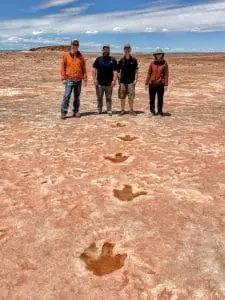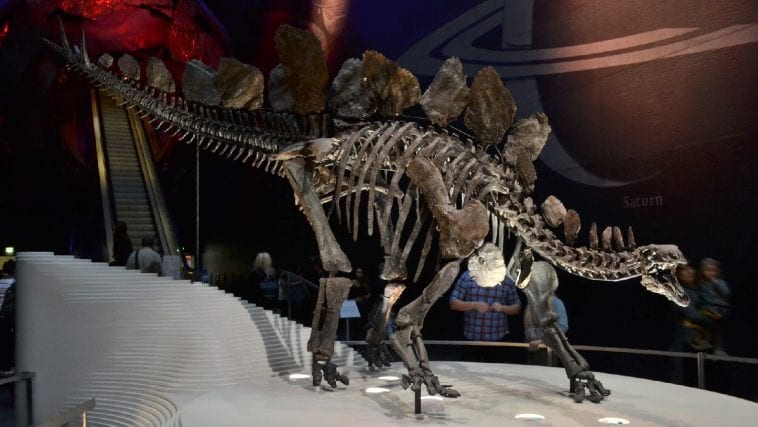[Originally published as the second half of Dinosaurs: A Biblical Creation and Flood Perspective]
Dinosaurs and the Modern Era
Dinosaur Soft Tissue
Interestingly, the word “dinosaur” doesn’t appear in our English Bibles — not because these creatures didn’t exist, but because the term wasn’t coined until 1842 by Sir Richard Owen, a pioneering British paleontologist and founder of London’s Natural History Museum, which I’ve had the pleasure to visit and guide tours in dozens of times.
As scientists began to uncover and study dinosaur fossils in the 19th century, the field of paleontology emerged, enriching our understanding of these magnificent beasts. Today, this field continues to provide compelling insights that complement the biblical narrative of a young, purposefully created earth.
One of the most fascinating breakthroughs in recent years has been the discovery of soft tissue remnants in dinosaur bones — findings that challenge conventional assumptions about the age of these fossils.
In the 1990s, paleontologist Dr. Mary Schweitzer stunned the scientific community when she uncovered preserved soft tissues, including flexible blood vessels, in a fossilized Tyrannosaurus rex femur. This discovery, initially met with skepticism, has since been replicated and expanded upon, sparking ongoing debates about what these remnants mean for our understanding of dinosaurs and their timeline.
Schweitzer’s work showed that the blood vessels in the T. rex bone were still flexible and contained structures resembling red blood cells. Under a microscope, these tissues displayed a level of preservation that seemed impossible for fossils supposedly 65 million years old.
The presence of collagen — a protein that degrades relatively quickly — further complicated the conventional narrative. Laboratory studies suggest that collagen and soft tissues should completely break down within thousands of years under typical conditions, yet here they were, seemingly intact in fossils assumed to be millions of years old.

Since Schweitzer’s discovery, other researchers have found similar soft tissue remnants in fossils from various locations around the world. Dr. Mark Armitage, for instance, has reported the discovery of soft tissues, including stretchy material and intact osteocyte bone cells within Triceratops horns and other dinosaur fossils. Armitage’s findings align with Schweitzer’s in demonstrating that such materials have been preserved far beyond what standard models would predict. These discoveries are not isolated incidents — they represent a growing body of evidence that raises fundamental questions about the assumed deep-time history of dinosaurs.
From a biblical creation perspective, these discoveries provide exciting confirmation of a more recent timeline for Earth’s history. If dinosaurs were created on Day 6 of Creation Week alongside other land animals and later survived the Flood (Genesis 6–8) aboard Noah’s Ark, their fossils could reasonably be expected to date back only thousands of years, not millions.
The preservation of soft tissue fits well within this framework, as it suggests that these creatures were buried rapidly and preserved under exceptional conditions, such as those created by the catastrophic global Flood.
Dinosaurs in Arizona: A Walk Through History

For those eager to experience the wonder of these ancient creatures firsthand, the Colorado Plateau offers an extraordinary window into the past. Just north of Flagstaff in Northern Arizona, an area near Tuba City is home to the remarkable Moenave Dinosaur Trackways. These well-preserved tracks, attributed to theropod dinosaurs such as Dilophosaurus and Coelophysis, allow us to literally walk in the footprints of giants. Each footprint tells a story of a time when dinosaurs roamed a dramatically different landscape — a story written in stone and preserved by God’s providence during the tumultuous days of the Flood.
At Canyon Ministries, we believe that exploring the evidence of God’s creative work should be both educational and inspirational. That’s why we’re proud to offer guided tours to the dinosaur tracks near Tuba City. Our tours are designed to bring together science and Scripture in a fun, engaging way — providing participants with a tangible connection to the biblical narrative of creation and the Flood.
On our tours, expert guides share fascinating insights into how these dinosaur tracks were formed, how they fit into the biblical timeline, and what they tell us about the incredible power and wisdom of our Creator. Whether you are a seasoned believer in biblical creation or simply curious about the intersection of science and faith, our tours provide an unforgettable journey into the past, right in the heart of the Colorado Plateau.
Dinosaurs are far more than ancient beasts; they are living testimonies to the magnificence of God’s creative work. Their existence — from their creation on Day 6 to their preservation through the Flood, and even to their survival into the post-Flood world—invites us to see the world through the lens of divine purpose and design. From their massive footprints to their mysterious past, dinosaurs remind us that the Creator’s design is always larger than life. Though they may have disappeared from our modern era, their legacy roars loud and clear, echoing the greatness of our God.






